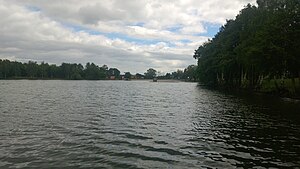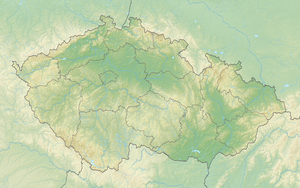Kamencové jezero
| Kamencové jezero | ||
|---|---|---|

|
||
| Alum lake with a view of the landscaped beach | ||
| Geographical location | one kilometer north of the city center of Chomutov ( Czech Republic ) | |
| Tributaries | no | |
| Drain | no | |
| Places on the shore | Chomutov | |
| Data | ||
| Coordinates | 50 ° 28 '21 " N , 13 ° 25' 30" E | |
|
|
||
| Altitude above sea level | 337 m | |
| surface | 16.3 ha | |
| length | 676 m | |
| width | 240 m | |
| volume | 285,000 m³ | |
| Maximum depth | 3.5 m | |
|
particularities |
only alum lake in the world |
|
The Kamencové jezero (German alum lake) is a bathing lake and natural monument in the Czech Republic .
geography
The alum lake is one of the two large lakes in Chomutov . It is located in the North Bohemian Basin, a good kilometer north of the city center of Chomutov at 337 m above sea level. M.
The Ústí nad Labem – Chomutov railway line runs north of the lake, with the Chomutov animal park behind it. East lies the reservoir Otvice ( Big Pond ), north of the smaller Kamenný rybník ( stone pond ) and to the northwest of Červený rybník ( Red pond ).
history
The origin of the lake lies in the Komotau Alaunta mine, which was recorded in 1588 . After the pit was closed in 1777, the remaining hole was filled with water. The resulting lake is the only alum lake in the world; another existed in Canada , but this has dried up. In the 19th century, the iron bath Alaunhütte was built on the northwestern bank of the lake.
The 16.25 hectare large and almost 3.5 m deep lake is now used as a bathing lake and forms a coherent recreational area with the Otvice reservoir. A special feature is the composition of the water, which contains around one percent alum as well as nitrogen, nitrates, chlorides, ammonia and iron. Because of the high algae content, which is harmless to humans, the water is biologically dead, meaning that no algae and blue-green algae can develop despite the shallow water . There is a spa at the lake.
The lake also gained fame through the painting The Alum Lake near Komotau, created by Ernst Gustav Doerell in 1877 .
